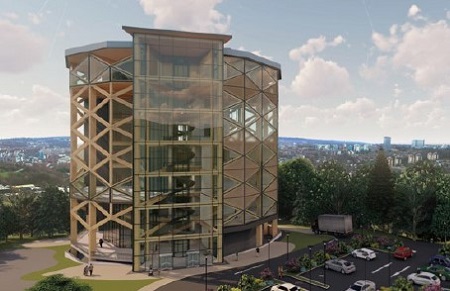Architectural Technology Studio 3

|
| This project won the Student Award for Excellence in Architectural Technology (Project) at the CIAT Awards 2019. It was undertaken as the second phase of an existing development proposal by Extreme, a global lifestyle brand and founder of the Extreme Sports Channel. |
Contents |
[edit] Outline
The proposal is set to bring back to life the site of the previous Sheffield Ski Village located at Parkwood Springs, which was burnt down in 2012 and has since suffered multiple arson attacks.
The brief for the project was to design an extreme sports facility with the main attraction being a 25m-high ice climbing wall. Other key spaces included an internal and external sports activity, an event space which had to be situated above the ice wall, a plant room large enough to service the ice climbing wall as well as the rest of the building, and a helter-skelter which had to be accessed from the topmost level. Site constraints set out in the brief stipulated that the existing ski slopes could not be constructed on and that the proposed building could not conflict with anything constructed in phase one of the development.
Since the site has been in a disused state for several years, the flora and fauna have overgrown and now hold a prominent presence. A flat exposed shelf cuts into the landscape at the base of the ski slopes which faces directly south subjecting it to a lot of solar gains; this means that the site itself can be easily viewed from many different locations across the city of Sheffield.
[edit] Main drivers
Taking into account the key aspects of the site and project brief, the main drivers of the project were:
- The ice climbing wall being the main attraction of the facility and thus situated centrally in the design where other visitors could have a view of the wall as they travelled through the building.
- The visual impact of the building for those visiting the site and those far away in varying locations around the city.
- The view of the Sheffield skyline from every level of the building, not just at the top where the event space is located.
- The sustainability of the design in managing the high energy demands of maintaining a frozen atmosphere and what the immediate and extended environmental impact would be of the site. Passivhaus standards are incorporated into the design to help minimise the cost of heating and cooling the building.
[edit] A change in approach
In taking a sustainable approach to the design and to also satisfy the project drivers, the success of the building came down to the primary structure which originally started as a monolithic concrete frame. However, material development and different approaches at making the building efficient, spacious and have a strong visual impact resulted in a repeating glulam frame construction with an in-situ concrete core.
The concrete core encapsulates the ice climbing wall and, in the process, efficiently segregates the frozen atmosphere from the other internal spaces in the building where the glulam frame acts as a shell. The concrete core has windows on the outer wall where visitors can observe any ice climbing. Glulam is known for being able to span large distances and so was a suitable choice for the 11m spans; these were needed to create the large, open spaces for the internal and external activities in order to provide a design which visually connected the spaces to one another, especially when voids occurred in multiple floor plates to open-up the whole building. The decision to have a glulam frame was also to create more aesthetically pleasing internal spaces as opposed to other structural materials when left exposed.
The aesthetic of the glulam frame is a repeating triangular pattern which creates a strong visual impact up close and from afar. The frame supports a curtain wall system manufactured by RAICO, which achieves Passivhaus thermal standards. This helps maintain the internal thermal environment as well as provide the views out of the Sheffield skyline at every level of the building. However, with it being an exposed site, direct solar gains will be an issue for the building. The proposal is to incorporate a dynamic façade which responds to the position of the sun and the internal temperature of the building throughout the day, at which point if it becomes too hot the façade will provide solar shading to reduce the solar gains. This dynamic façade will also add to the visual impact of the building as it will impose a ‘live’ appearance which will be more interesting than static solar shading.
The building will be serviced through mechanical ventilation with heat recovery (MVHR) to ensure that Passivhaus standards are met. Service ducts take advantage of the central circulation space which has a set of helical stairs that connect to every level. The MVHR works in tandem with the services for the ice climbing wall to ensure that heat and energy are being recycled as much as possible in the building. This helps reduce initial energy expenditure, while the roof is fitted with an extensive number of PVs to capitalise on the exposure of the south-facing site.
To help encourage the flora and fauna of the site, an intensive green roof is used to imitate the conditions of the site. This approach will extend the varying viewing terraces and balconies at different levels of the building.
The green roof will also help manage excess storm water and reduce the load on the drainage system. It also assists to cool down the PVs by absorbing solar gains instead of reflecting and keeping them functioning more efficiently for longer.
[edit] Judges’ comments
The conceptually bold design and its complete technical resolution has been developed holistically which illustrates the nature and breadth of the architectural technology discipline. This complex design demonstrates immense creativity and a balance between the architectural design aesthetics and the technical design to create a unique form and structural solution. A sustainable MEP (services) strategy was selected to integrate with the structure and create the necessary comfort conditions in such a multi-complex functional environment. The solution clearly demonstrated a deep and broad knowledge of the different and challenging aspects of this design project.
The judges concluded that the key criteria of functionality, inclusivity, sustainability and performance were comprehensively demonstrated, indicating a high level and rounded understanding of architectural technology and its place within design and architecture, and the role and function of the architectural technologist.
[edit] About this article
This article was provided by the Chartered Institute of Architectural Technology (CIAT). It was written by Albert Greenhalgh, Sheffield Hallam University and first appeared in CIAT's AT Journal, Issue no 131, Autumn 2019. It can be accessed HERE.
Other articles by the CIAT on Designing Buildings Wiki can be accessed HERE.
[edit] Related articles on Designing Buildings Wiki
- Adhesives.
- Base construction.
- Composites.
- Confederation of Timber Industries.
- Cross-laminated timber.
- Engineered bamboo.
- Laminated veneer lumber LVL.
- Modified wood.
- Multi-storey structure.
- Oriented strand board.
- Plywood.
- Secondary ventilation stacks in tall buildings.
- Skeleton frame.
- Softwood.
- Structural systems for offices.
- The skyscrapers of the future will be made of wood.
- Timber preservation.
- Timber vs wood.
- Timber.
- Tower.
- Types of timber.
- Wood and hybrid structures.
--CIAT
Featured articles and news
Deputy editor of AT, Tim Fraser, discusses the newly formed society with its current chair, Chris Halligan MCIAT.
Barratt Lo-E passivhaus standard homes planned enmasse
With an initial 728 Lo-E homes across two sites and many more planned for the future.
Government urged to uphold Warm Homes commitment
ECA and industry bodies write to Government concerning its 13.2 billion Warm Homes manifesto commitment.
Places of Worship in Britain and Ireland, 1929-1990. Book review.
The emancipation of women in art.
CIOB Construction Manager of the Year 2025
Just one of the winners at the CIOB Awards 2025.
Call for independent National Grenfell oversight mechanism
MHCLG share findings of Building Safety Inquiry in letter to Secretary of State and Minister for Building Safety.
The Architectural Technology Awards
AT Awards now open for this the sixth decade of CIAT.
50th Golden anniversary ECA Edmundson awards
Deadline for submissions Friday 30 May 2025.
The benefits of precast, off-site foundation systems
Top ten benefits of this notable innovation.
Encouraging individuals to take action saving water at home, work, and in their communities.
Takes a community to support mental health and wellbeing
The why of becoming a Mental Health Instructor explained.
Mental health awareness week 13-18 May
The theme is communities, they can provide a sense of belonging, safety, support in hard times, and a sense purpose.
Mental health support on the rise but workers still struggling
CIOB Understanding Mental Health in the Built Environment 2025 shows.
Design and construction material libraries
Material, sample, product or detail libraries a key component of any architectural design practice.
Construction Products Reform Green Paper and Consultation
Still time to respond as consultation closes on 21 May 2025.
Resilient façade systems for smog reduction in Shanghai
A technical approach using computer simulation and analysis of solar radiation, wind patterns, and ventilation.
























